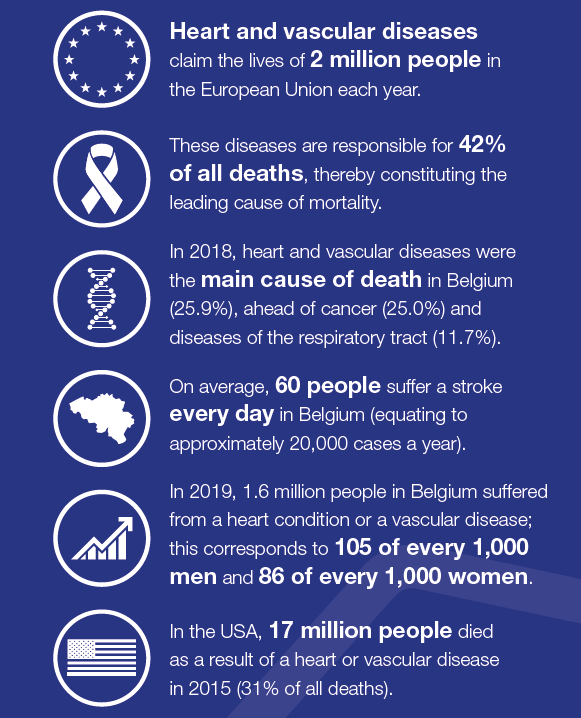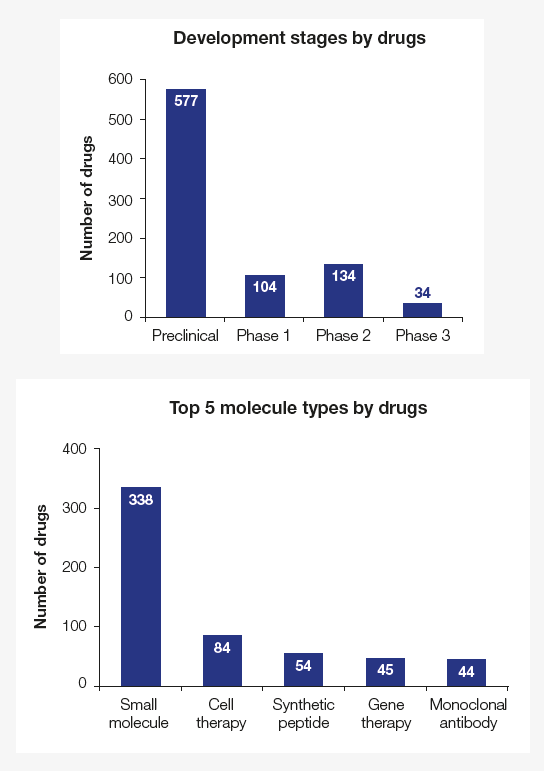An interview with Dr Eric Wyffels, cardiologist at the Cardiovascular Center OLV Aalst (Belgium)
In 2019, no fewer than 1.6 million Belgians suffered from heart or vascular disease of one form or another.
At the same time the statistics show that these diseases remained the principal cause of death in our country, ahead of cancer and diseases of the respiratory tract. Despite these alarming findings, medical specialists also recognize signs of hope.
A greater focus on a healthy lifestyle and the breakthrough of innovative treatment approaches are creating new opportunities. Dr Eric Wyffels,
cardiologist at the Cardiovascular Center OLV Aalst (Belgium), gives a detailed explanation.
Heart and vascular diseases: A wide range of disorders and ailments
Eric Wyffels begins by pointing out that ‘heart and vascular diseases’ is an umbrella term used to denote various diseases of the heart or blood vessels. “Heart and vascular diseases are, to a large extent, disorders affecting the vascular wall of blood vessels. When (coronary) arteriosclerosis occurs, this manifests itself in a broad range of heart and vascular diseases that can appear in chronic or acute form.”
“If we go on an exploratory trip around the human body, we will see various vascular disorders that can occur. If the cerebral artery in the brain becomes blocked due to the formation of a blood clot, this leads to what is called a cerebrovascular accident, better known as a cerebral infarction or stroke. In Belgium, 60 people suffer a stroke every day. This complaint leads to a large number of hospitalisations and deaths, among young and old alike. The aorta (the main vessel in the arterial network) can tear due to so-called atherosclerosis or a hardening of the outside of the artery, combined with soft deposits of fatty material on the inside (‘atheroma plaque’). The main component of atheroma plaque is cholesterol.”
“If we descend further in the body, the coronary arteries (or coronary blood vessels) originate in the thoracic aorta. When a blockage occurs, this can lead to effort angina, myocardial infarctions, and related pumping-ability problems. Lower still, we come to the abdominal aorta that, in the event of dilatation, can tear open and cause sudden death.”
“If the peripheral blood vessels in the legs become blocked, the syndrome of the so-called “window-shopper’s disease” may occur, with chronic anoxaemia in the lower limbs.”
“Furthermore, in addition to anoxaemia, there are other factors that can give rise to heart diseases. For example, high blood pressure can lead to cardiac arrhythmias, clot formation, heart pump failures or a thick heart muscle that no longer performs with full efficiency. And, of course, among older people we also see degenerative causes, including such things as wear and tear of the heart valves, with all the negative consequences that this has for the heart’s pumping
ability.”
A few more remarkable figures
In addition to the aforementioned figures, Eric Wyffels has a
few more remarkable facts and figures to share. “In 2017,
17% of adult men and 36% of women in the United States had
some form of heart or vascular disease. We have, moreover,
seen a drop in heart and vascular diseases worldwide in
recent years, but unfortunately that positive trend is not being
sustained everywhere. For example, we note a conspicuous
rise in Eastern Europe, where a whole host of environmental
factors – such as air pollution – are having a negative impact.”
“Incidentally, did you know that in Belgium, it is not coronary
heart diseases, but suicide that is the main cause of death
among men under the age of 75? That figure, too, is food for
thought…
What cardiovascular risk factors play a role?
The list of cardiovascular risk factors is rather extensive.
“Of course, hereditary defects within the family, as well as age and sex, are risk factors that cannot be controlled. On the other hand, there are factors that we can do something about to help reduce the risk to the heart and blood vessels; such factors include obesity and lack of physical exercise, unhealthy dietary habits, high cholesterol, smoking, diabetes and high blood pressure. An interesting fact in this respect is that in the context of increased exercise, the combination of cardio-training and muscular strength-training is most effective when it comes to reducing the risk of heart and vascular diseases.”
“The importance of the impact of environmental factors on the heart and blood vessels is often underestimated. Environmental pollution can silently make you ill, and yes, even kill you. Moreover, an excessive and chronic exposure to noise pollution (here, we can think of people living near an airport or alongside a busy main road) leads to a chronic level of stress, involving the production of the hormone cortisol and resulting in poor quality of sleep and a sleep deficit.”

Bio
Dr Eric Wyffels
Dr Eric Wyffels is Coordinating Department Head and Managing Director of the Cardiovascular Center OLV Aalst, which brings together 36 cardiac specialists from different Flemish hospitals. He is a much-requested speaker at seminars and lectures on the subject of heart and vascular diseases.
Growing social awareness
In his long career as a heart specialist, Eric Wyffels reflects on positive developments in the availability of quality information and strategies aimed at helping to prevent heart and vascular diseases. “Of course, I can only applaud the increased focus being placed on a healthy diet and lifestyle. The ‘health literacy’ among policymakers themselves has also improved. However, there is still work to be done to make patients from lower socio-economic areas aware of action items designed to tackle risk factors. Measuring is knowing. The more people who are screened in a timely fashion to gauge their cholesterol and hypertension levels, the quicker we can make adjustments through a healthy lifestyle, medication or other interventions. Certainly, in the case of people with a family history, it is extremely important to arrange for screening as quickly as possible, because it is the lifetime exposure to lipids in the blood that determines how the atherosclerotic situation evolves in the body.”
Major developments in research and treatment
Eric Wyffels has also seen considerable progress made in the treatment of heart and vascular diseases, emanating from research activities in the therapeutic area. What does he consider to be the most important breakthroughs in this field? “In the last ten to fifteen years there has been an impressive shift towards minimally invasive treatment. In the past, we often had to fit a bypass or perform bridging in atherosclerosis patients. These days, the modern range of stents and devices gives us, as heart specialists, the opportunity to perform minimally invasive treatments that are associated with advantages, including a short hospital stay and less bothersome side-effects, for our patients.”
“Availability of new and improved instruments has also had a positive impact on the treatment of structural heart problems. For example, thanks to transcatheter technology, we can now insert a heart valve through a patient’s groin. The treatment of cardiac arrhythmias or heart pump failures has developed considerably in recent years, with electrophysiological research and device therapy, to name just two areas. In this respect I refer to special pacemakers, defibrillators and cardiac resynchronisation treatments.”
“And remote screening and monitoring of heart patients – with a screening of all physiological parameters – is another huge step forward for specialists and patients alike. On the basis of artificial intelligence and machine learning, we are increasingly better placed to predict when a patient’s medication needs adjusting in order for the patient to avoid hospitalisation. In the past we were often too late. Patients also had to stay in hospital for longer periods. Now our remote monitoring devices can indicate in advance that our patients should be contacted in order for their medication to be adjusted. In this way we are reducing unnecessary and expensive hospitalisation days to a minimum, which also impacts positively on the cost price for our health service.”
“The deployment of robotics in cardiovascular treatments is also bound to increase in the coming years. At the moment this technology is still in its infancy, but I expect notable breakthroughs in this area very soon. I am also very enthusiastic about new developments in medical imaging, with rapid developments, for example, in MRI [magnetic resonance imaging] and CCTA [coronary computed tomography angiography].”
Heart and vascular diseases in figures:

Sources: Dr Eric Wyffels, Belgian Heart Foundation, Statbel
Global cardiovascular disease statistics
(for 2019*):
- ~18.6 million deaths were attributed to cardiovascular disease worldwide; this equates to a 17% increase over the past decade
- The highest cardiovascular disease-related mortality was
in Eastern Europe and Central Asia - Worldwide, it has been estimated that 197.2 million people were living with ischemic heart disease, and that the prevalence of stroke was 101.5 million people
*The latest year for which worldwide statistics are calculated.
Sources: American Heart Association. 2021 Heart Disease & Stroke Statistical
Update Fact Sheet Global Burden of Disease; American Heart Association.
Annual Statistical Update Report. News Release 27 January 2021
Cardiovascular Disease Global
Pipeline Drugs in Development

- There is an encouraging global pipeline of compounds
currently under investigation in preclinical and clinical
studies for cardiovascular disease - In similarity with the marketed treatment landscape,
small molecules dominate the pipeline landscape - In contrast, the pipeline landscape comprises far more cell therapies, synthetic peptides, gene therapies and monoclonal antibodies, compared with the marketed treatment landscape (number of drugs: 5, 25, 0 and 7, respectively). The emergence of such compounds
in the drug pipeline represents increased interest in novel approaches and gives an indication of how the cardiovascular disease therapy area is set to evolve in the future
The Cardiovascular Center OLV Aalst pools expertise and know-how
As a prominent cardiologist, Eric Wyffels has been active for many years in the Cardiovascular Center OLV Aalst, a multidisciplinary centre of expertise in the OLV Hospital in Aalst. This unique partnership between heart surgeons and cardiologists yields a substantial added value. Eric is full of praise for this alliance. “I’m chairman of this ‘holding structure’, which consists of a clinical pillar and various research structures. Under the motto ‘unity in diversity’ and via a mix of clinical and more scholarly profiles – accounting for 36 full partners working in various Flemish hospitals – we manage to work extremely efficiently and achieve an excellent cross-fertilisation in the field of medical innovation.
So, in these times of savings in healthcare, we are, in fact, even creating an enabling environment and that’s something we can be very proud of!”
Inspiring websites:
- Cardiovascular Center OLV Aalst:
www.hartcentrumaalst.be/en
- Belgian Cardiological Association:
www.liguecardioliga.be/belgischecardiologische-liga/
- Belgian Heart Foundation:
www.belgianheartfoundation.be
